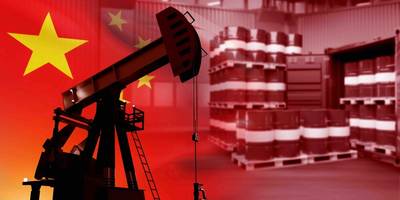US Sanctions on Iranian Oil Target Sinopec
The latest U.S. sanctions on Iranian petroleum exports deal a blow to Chinese refining giant Sinopec by targeting a terminal through which the state major handles one-fifth of its crude oil imports, industry executives and analysts said.
The sanctions announced on Thursday further complicate U.S.-China relations, coming ahead of planned talks between Presidents Donald Trump and Xi Jinping later this month.
The move follows China's decision to tighten controls on rare earth exports and reflects Washington's continued efforts to restrict Iran’s oil trade with its largest customer.
Rizhao Shihua Crude Oil Terminal Co. Ltd, half-owned by a Sinopec logistics unit, was among the entities listed by the U.S. Treasury in a round of sanctions that also includes ships transporting Iranian crude oil and liquefied petroleum gas, as well as an independent Chinese refinery.
Rizhao Shihua terminal, in the Shandong province city of Lanshan, was designated for receiving Iranian oil on board sanctioned vessels, the U.S. said.
KEY CRUDE HUB UNDER SCRUTINY
The terminal, which runs three berths that can service VLCCs, very large crude carriers, is 50%-owned by Sinopec Kantons Holding, a Sinopec-controlled logistics operator, while the remainder is held by local-government-backed Shandong Port Group's Rizhao Port, according to Chinese business portal Qichacha.
The majority of crude oil passing through the terminal is handled by Sinopec, according to tanker tracker Vortexa and two industry executives familiar with the port.
Sinopec has steered clear of buying Iranian oil, traders and analysts have said.
A Sinopec spokesperson did not immediately comment.
Calls to Shandong Port Group and Rizhao Port went unanswered and Sinopec Kantons did not immediately respond to a request for comment.
The latest measures bring to five the number of sanctioned oil import terminals in the refining hub of Shandong, accounting for half of the province's capacity to handle VLCCs that carry 2 million barrels of oil each.
VESSELS MAY SEEK ALTERNATIVE PORTS
Shandong, where independent Chinese refiners are clustered, is the largest destination for oil shipments from sanctions-hit Iran, Venezuela and Russia.
"Compared to the previous round of sanctions on Chinese terminals, the impact could be larger," said Samuel Kong, senior analyst at FGE, which estimates that only 10-20% of the oil imported at Rizhao is from sanctioned sources.
"In the near term, we could see disruptions to discharges around Rizhao, and vessels carrying non-sanctioned barrels might seek alternative ports in Shandong to unload their cargoes."
Spot VLCC freight rates for the Mideast-China route gained 3% on Friday, several shipping sources said, buoyed by concerns of congestion or discharge delays resulting from sanctions.
Last year, Sinopec imported about 804,000 barrels per day via the Rizhao Shihua terminal, 20% of its total imports, according to Vortexa and one of the industry executives.
To avoid using the terminal, Sinopec would be forced to re-direct shipments to other facilities to supply at least two major subsidiary refineries, Sinopec Luoyang Petrochemical in Henan province and Sinopec Yangzi Petrochemical in Jiangsu province. Both plants are connected to the Rizhao terminal via pipelines, the two executives said.
These two plants have a combined crude processing capacity of 420,000 bpd. Rizhao terminal indirectly serves several smaller Sinopec refineries along the Yangtze River via pipelines, said a third industry official familiar with Sinopec's refining system.
As a workaround, Sinopec may ramp up imports at Ningbo or Qingdao port, or raise throughput at other nearby plants to compensate for possible production cuts at Luoyang and Yangzi, said a second executive, who is close to Sinopec.
(Reuters)





